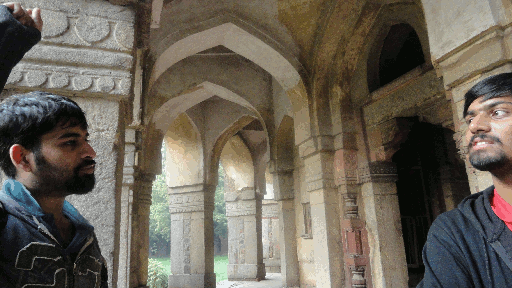Warning: long, long rant ahead.
In the fourth year
of architectural training, you do only one design project: housing, which is,
frankly, large and detailed enough to occupy the entire semester. Every year
the faculty decides on a common theme and students try and attempt their own
version of it. Last year (or was it the year before last?) the theme was
futuristic housing. So everyone tried to make funky forms and what not.
This year we have
to design inclusive housing, the meaning of inclusive being not exclusive,
but the real debate arises when you try to define it further: inclusive to what
extent? What do we want to achieve: social inclusivity -different
races, ethnicities, genders, ages, disabilities- or economic
inclusivity -different classes- or maybe even both?
As part of the
class's preliminary research, me and my housing partner, Varun (it’s done in
teams of two) were told to present on this very issue (before we found out it
was to be our theme). I don't want to get into the inclusive debate, because I
am frankly sick of talking about this, needless to say Varun and I spent many,
many hours thrashing it out. Not surprisingly -especially considering the
government policy of 'forcing' private developers to provide for a minimum
amount of EWS (economically weaker sections) and LIG (low income groups)
dwelling units in any housing project- we started talking economics and
capitalism and socialism and the whole brouhaha.
Varun is staunchly
on the capitalist side. He sometimes wonders whether a completely liberal
economy with little or no government regulation might not be the way forward.
As for me, while I felt sorry when I saw the living conditions of the poor, a
part of me also felt that they couldn't afford the things they needed because
they didn't have money, and that was OK, because we live in a fair economic
system where only the purchasing power maters. I did economics in school, and
it seemed pretty basic to me- the market forces of demand and supply govern
everything.
 |
I just love the cover design of The Face You Were Afraid to See.
How awesome are the photograph, the font, and
the yellow against the stark black and white, all put together?
|
Bhaduri in
particular makes very convincing arguments against liberalization
and globalization. In a globalized economy and in a free trade
system, producers from a still developing country are required to compete in
the world market. The only way they can succeed is if they reduce the price of
the commodity they are trying to sell (less price as compared to alternatives,
more demand and thus profit). This is generally done by reducing the costs
incurred in producing that commodity: labour, raw material, land, etc.
To reduce labour
costs, most industries opt for mechanization and try to increase the
productivity of each individual worker, thus minimizing the total number of
workers. This works perfectly well on a micro level, for one firm. The problem
arises when all (or most) of the producers start doing the same, especially in
a labour intensive country like India.
When so many
employers reduce jobs, the demand becomes much greater than the supply, and
workers are happy to work in worse conditions than prescribed by the law just
to make a living. Also, every worker becomes immediately replaceable,
promoting the hire-and-fire system and casualization of labour. This is a lot
like the informal construction labourer market- there assembles a huge crowd of
such labourers near Kotla Mubarakpur who are looking for work on a day-by-day
basis. Because there are so many competing for so few jobs, they willingly work
for less than the daily wage prescribed by the government. This whole time,
neither the builder nor the industry owner is doing anything wrong because they
are just accommodating the market forces- higher the supply, lower
the price. They would have to be seemingly stupid to pay more for the labour.
Our traditional
economy was based on labour-intensive agriculture and other allied fields. With
industrialization came the shift to the secondary and tertiary sector. In
recent years, in order to ‘stay on the good side’ of international financial
organizations such as IMF and the World Bank (the same reason for the move to
free trade, which most benefits the first world members) the government has
decided to promote private-public partnerships, wherein the government acts as
a facilitator for the corporations. In fact, the relationship between political
powers and big corporations has a long mutually beneficial history. The government
has often used the Land Acquisition Act, for example, to take land away from
people who had been living on it for generations (with little to no
compensation) for ‘public purpose’ and give it to industrial giants at rock
bottom prices- subsidising for them the initial cost of land, and in the case
of the mineral rich Chattisgarh and Jharkhand, the raw material. No doubt there
is substantial exchange of money on the side. This, I think, is where the
corporations are at fault: they are willing to pay bribes to facilitate this
transaction, instead of relying on the basics of economics and capitalism- the
logic that they could have bought out the original owners simply by appealing
to their self-interest. The government should also stay out of it; there are
other ways of encouraging industry.
This also means
that these people have no options but to look for jobs in other sectors. In
essence, this means that there are many -the majority, in fact- who are
unemployed or marginally employed in the country and who thus have very low
purchasing power. They are unable to contribute significantly as
buyers. But, yet, our economy is experiencing very high growth, even
though the majority is pitiably poor. This is because money is increasingly
getting concentrated in the hands of a privileged few: the rich are
getting richer, and the poor are getting poor, at least relatively if not
absolutely. The rich demand more and more products, and the industry responds
by producing for them. This is what is driving our economy.
Thus, the major
demand in the market is for products for the rich- products which by virtue of
their character require specialized, often large scale, production
techniques and technologies, not to mention marketing and management. Bhaduri's
oft stated example is of bottled water- we have
many expensive variants of in the market even while a significant
portion of our population has no access to potable water. This is almost like
the Great Famine (1845-50) when the Irish were too poor to buy food, and the
population reduced by 20-25%. But, at the same time, Ireland was a net exporter
of food- for example, corn was shipped to Britain where it could fetch a better
price in the market.
Small scale
producers are unable to compete with the big businesses and corporations, not
just in terms of technologies but also the economies of production and scale. This
results in a sort-of poverty trap, with the added result that the rich are
becomingly increasingly indifferent to the poor, who are unable to contribute
either as buyers or sellers. The only way out of this cycle would be better
education, health and other public service, but under the new economic policies
the investment in these sectors has fallen considerably.
Going by how the markets
operate, under no regulation, producers would logically only produce those
commodities for which they could get the most demand and best price. In today’s
inequitable conditions, this would mean that even while the poor can barely
make a living and thus going without roti,
kapda and makaan, the rich are
driving our economy forward to never before seen heights.
Obviously, then, high economic growth does not necessarily
mean economic development. The growth is powered by the increase in purchasing
of the power, and, against conventional knowledge, this growth is not trickling down to the poor. All
those clichéd sayings that ‘there are two Indias’ is actually true.
This inequity is
only rising. Bhaduri thinks that it’s only a little while before the economy
will crash and burn. Like what happened during the Great Depression (1930s).
Right before, in 1929, 0.1% of America’s population controlled 34% of the
wealth, owning as much money as the bottom 42%.
America was able
stand on its feet again with the help of Keynes’ and Roosevelt’s ‘The New Deal,’
which focused on increasing public expenditure and greater regulation of
financial institutions and trading. The policies focused on always ensuring
that there was money flowing in the economic system. After the Second World War,
America’s plans to help the impoverished European and East Asian countries –the
Marshall Plan- also hinged on this. They provided a significant amount in aid,
but with the proviso that 90% of it be matched by the receiving government (the
rest 10% being a repayable loan with interest), and also that the recipients
co-operated in an open market. Thus, most of this money was spent on American
good and the policy meant that more money flowed back into the American
economy.
Anyways, my point is that even America imposed stringent
controls on its economy in the early stages, at least until the 80s when Milton
Friedman started questioning the importance of government intervention
-Monetarism. Of course, both Monetarism and Keynesianism hinge on ever-increasing
consumption -disparaged quite famously in the Story of Stuff- with its associated negative cultural effects.
So, maybe, like Bhaduri advocates, the Indian government
should also impose more regulations and dramatically increase public
expenditure on basic rights like education and health, and also on shared
infrastructure, thereby creating employment.
Take the example of South Korea -a rich and developed
country- which got there by following a form of “State Capitalism” which
included protectionist tariffs and government expenditure in infrastructure. On
the other hand, many African countries who got aid from the World Bank and IMF -providing
they opened their markets- are still struggling.
I’m not against free trade and liberalization and
globalization, I just think that maybe the Indian economy is not yet ready for a
completely open market. Maybe we should encourage free trade in some sectors
while still protecting the others.
Argh, this is such a confusing issue where every turn means
a new minefield. It seems that these days Varun and I are always arguing about
this, and our opinions are never fixed, nor our ideas clear, because we are
never able to completely defend our reasoning to each other. Bleh.






![See in fullscreen [Press F11] Fullscreen](http://btemplates.googlepages.com/fullscreen.gif)


































